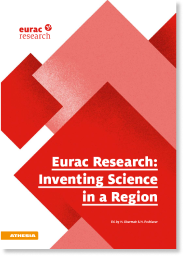Preface of the Editors
We were guided by the conviction that a comprehensive picture of our house of science could only emerge if its collective character and abundant diversity of voices were adequately represented.
Hannes Obermair
This publication was created on occasion of the 30th anniversary of the founding of Eurac Research. Encouraged by management, we as editors have strived to originate a collaborative project in spite of all the limitations of the recent pandemic. We were guided by the conviction that a comprehensive picture of our house of science could only emerge if its collective character and abundant diversity of voices were adequately represented.
The most important task of the book is to communicate the institution, its goals, concerns and fields of activity, and its people to a broader public. In a historically short, but operationally and substantially rich phase, the research institution has advanced to become the central player of science and research in South Tyrol. This was only made possible because Eurac Research not only works in and acts on an interregional level, but also interacts with countless institutions and actors throughout Europe and the rest of the world and is now integrated into a global network of knowledge and knowledge production. Therefore, the publication, in addition to all its preoccupation with past developments, is essentially riented towards the future – a common thread running through all the contributions and interviews is the deeply rooted awareness that science and research are essentially determined by their ability to have a prognostic and socio-technical effect and to proactively shape the enormous challenges of current and future crises.
All too often our day-to-day work makes us forget what constitutes the impetus of science and research.
Harald Pechlaner
However, the book also aims to create awareness internally and to give all Eurac Research employees a clear profile of their working environment. All too often our day-to-day work makes us forget what constitutes the impetus of science and research – passion, knowledge gain, and a willingness to change. Thus, the publication is also a call to constantly reappropriate these dimensions in a confident and reflective manner.
To get to the bottom of Eurac Research’s particular phenomenology, we have chosen to give the book a double structure. This “double helix” is both analytical and dialogical. A roundelay of 16 essays strives to penetrate the content of the set of questions with which our institution is concerned – organized into the five sections of Connectivity, Development, Evidence, Interdisciplinarity, and Nature & Society. These patterns form the epistemological matrix of Eurac Research.
The 12 topic-centered interviews, on the other hand, offer science in conversation – through dialogue with Eurac Research scientists, a broad web of research content, personal development paths, and proactive future orientation emerges.
The fact that this project was made possible is owed to many. First, our thanks go to the management, whose trust we cannot appreciate enough. Next, we would like to thank the authors who introduced us to socially relevant issues in their committed contributions. Additionally, we would like to express our gratitude to everyone who was available for an interview. We owe the fact that the overall composition was made possible to the dedicated efforts of the Center for Advanced Studies and the communications department of Eurac Research. Finally, we would like to express our appreciation to the management for all the encouragement, respect and recognition that constitute the very spirit of our house and unites all those working here into one big family of science.
Hannes Obermair, Harald Pechlaner
Editors
